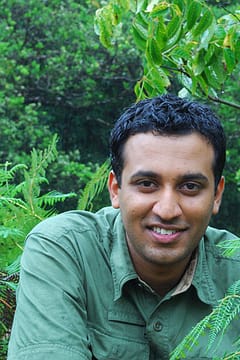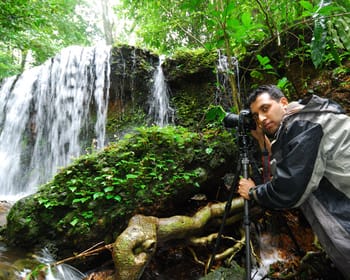Bangalore has seen the success stories of hundreds of young men and women who have, apparently, taken to information technology like a duck to water. So it is interesting to talk to people who are the ‘other side of the coin’, so to speak….who have turned their back on careers in this lucrative field, and are branching out in directions dictated by their hearts, rather than by economic necessity.

Amoghavarsha: Wildlife photographer
Meet Amoghavarsha JS, a young man who has done just this. “When I finished my Pre-University,” he says, “I knew I loved technology, and, so I decided to study Computer Science”. He studied at Administrative Maintenance College, and graduated in 2004. Serendipity had a hand in his getting his first job. “I knew of Amazon through a friend, and decided, as a lark, to build a website for their recruitment,” he laughs. Impressed with his work, Amazon gave him a paid internship for six months, and this worked so well, that he was offered a job there when he graduated, without having to go through the multiple rounds of interviews that normally characterise recruitment at such large IT firms.
The long shot
It was at this time that he invested in his first digital SLR- a Canon. Being an avid wildlife enthusiast, he also bought himself a Maruti Zen car, and went off into the jungles near Bangalore as often as he could, developing both his love for, and his skill at, photography. “Just for fun, I once printed 40 of my photographs and took them to the Amazon office,” says Amogh modestly. “To my great surprise, they all got sold.”
Being adventurous was always a part of his personality, too. He took his trusty Fiero motorbike, went off on a trip, alone, to Leh and Ladakh in 2006 and brought back, both, amazing memories of hairsbreadth escapes and soul-stirring beauty…a lot of which had been captured in his photographs.
However, after two years of working at Amazon, the work got repetitive and boring and Amogh missed the excitement of the initial heady days. He stuck on for a while, hoping that these were only the ‘slog overs’, when a chance of joining a start-up software company came up. He found the offer exciting, and decided to quit Amazon and join up. “It was a chance to build a software product from scratch,” he says, “that was very challenging.” The job lived up to its promise, and he continued to work there. When, however, the product was developed and stable, the call of the wild became stronger.
Mid-close up
Amogh decided that he would work for three days a week as a programmer, and devote the other four days to see how a career in photography could be developed, to use a pun. His employers at the startup were very supportive of this kind of unorthodox arrangement, not least, because he delivered his contribution on time and in good enough quality for them to agree to the arrangment. “Even at the startup, I had someone setting an example of following his passion…the Chief Technical Officer is a fairly successful restaurateur for several years now,” he laughs. Amogh started putting out the word that he was willing to accept professional photography assignments, and soon these started coming his way. One shoot was for Mahindra Holiday Resorts, which had him flying to various resort locations around the country. He found the travel fun, and in the process, also built up a good database of contacts. The loss of income from the IT start up seemed to be made up pretty well by the assignments he was getting.

Amoghavarsha on one of his photography excursions
Simultaneously, Amogh was also doing some amount of personal travel and photo-documentation, which allowed him to build up his portfolio. Several trips into the forests of the Western Ghats began to give him a certain reputation as a wildlife photographer. By this time he had changed his equipment to a Nikon D80, and he had also invested in lenses and tripods. A chance visit to a camera store on Cunningham Road, called Pixetra, also led to some interesting avenues. Amogh became one of Pixetra’s ‘photo ambassador’ at that time. For the newly-created Pixetra Photographic Club, he conducted photography workshops at Thekkady, Bhadra and a couple at the Bannerghatta Forest area, where those who had bought equipment at Pixetra could come and learn how to use their cameras optimally.
Though Amogh has never entered a formal competition, the quality of his photographs speak for themselves. His photograph was featured in last years’ World Wildlife Fund desk calendar, and he was showcased in the July issue of ‘Better Photography’, the prestigious Indian photo magazine. He has also done a couple of photo shoots for Citizen Matters.
Zooming in
The decision, therefore, to quit the software development company completely and work as a full-time professional photographer, was almost inevitable, he feels. At this time, he also met Sandesh Kadur, who runs a wildlife photo/documentary producing company called Felis Creations. The previous photographer had left, and Sandesh was looking for a photographer who could also help with the Felis website. Amogh fit the bill admirably, and a new partnership was born, with Amogh working part-time for Felis, as and when the work demanded it. The rest of the time, he was free to do his own assignments and travel. He has also moved into conducting wildlife expeditions and photography workshops on his own. An expedition with about ten members to the Agumbe Rainforest Research Station (ARRS) was a great success, as have been the weekend residential workshops that are held in a resort in the Bannerghatta Forest area. His tie-up with the Agumbe Rainforest Research Station is a very wildlife-oriented enterprise. The ARRS works on several field studies in the Western Ghats, plays an educational role with the local people, and has a noted ongoing telemetry study of the habits and habitat of the King Cobra. Amogh does not teach photography on these expeditions, however, which are for naturalists who are already into photography; he prefers to teach the basics of the craft at his photography workshops, where he explains both the technical aspects of digital cameras, and the aesthetic aspects of photography.
Amogh says that careful maintenance of the equipment is a major part of professional photography. This young photographer uses a Nikon D80, which he refers to as his ‘workhorse’; a Sigma 105 mm f/2.8 macro lens, and a range of Nikon lenses: 70-200mm f/2.8 VR (Vibration Reduction), 50 mm f/1.8, 12-24 mm f/4, and 18-55 mm f/ 4-5.6. His accessories are a Nikon 2X teleconverters, a Nikon S900 Speedlight, a Manfrotto tripod, and an IR remote. A Lowepro bag houses his kit while travelling, and it has a waterproof cover for rainy conditions.
What tips does he have to offer to an amateur photographer? When shooting wildlife, Amogh insists, being a naturalist first, and understanding the animals really helps. With landscapes, it is good to understand the direction and intensity of the sunlight. In the field, he says, keeping the equipment ready at hand at all times is crucial. A lot of spontaneous photography happens this way. One should also understand the technical aspects and performance abilities of one’s camera and lenses, and should set them for optimum performance. Getting a good shot is very important, rather than trying to enhance a poor image with post-processing, which should be kept to a minimum, he feels.
So how does he feel about the life he leads now, a few months into this new avatar? “Life is more balanced, at least, as far as I am concerned,” he says.”Of course, earning money will never be an easy task, but I have the confidence that I will be able to do it.” Networking with people, he feels, is one of the major aspects of freelancing, as many assignments come through this route. “I think it’s important to keep talking to people, and also to keep an accurate gauge on the market value of one’s work,” he opines. He wants his wildlife photography to be able to bring nature to the people who cannot go to the forests and wilderness. He would like to eliminate the fear of wild animals that many people have, and instill in them an admiration of nature instead. He says that ethical wildlife photography, where the photographer takes care not to harm wildlife, is essential.
However, Amogh does sound a note of caution. “I seem to have timed my entry into professional photography at a fairly tough time,” he smiles wryly. “With the economic downturn that has happened, things are definitely tougher, and I take a lot of effort to try and get good assignments.” Also, being a one-man show can be daunting at times, taking care of appointments, accounts, networking and travel schedules on one’s own, he says,”It’s definitely a tough profession to follow, and I would ask anyone who wants to take this path, to consider options carefully before taking it up.”
Amogh still ensures that ‘general’ shoots don’t take up all his time, and leaves aside enough time for the visits to the wilderness, that feed both his soul and his reputation as an up and coming wildlife photographer. He hasn’t thought too much about the long-term implications of his career choice, but feels that the future will take care of itself. Let’s wish this young man success with his newly-launched career!
To see Amoghavarsha’s work, visit www.amoghavarsha.com⊕